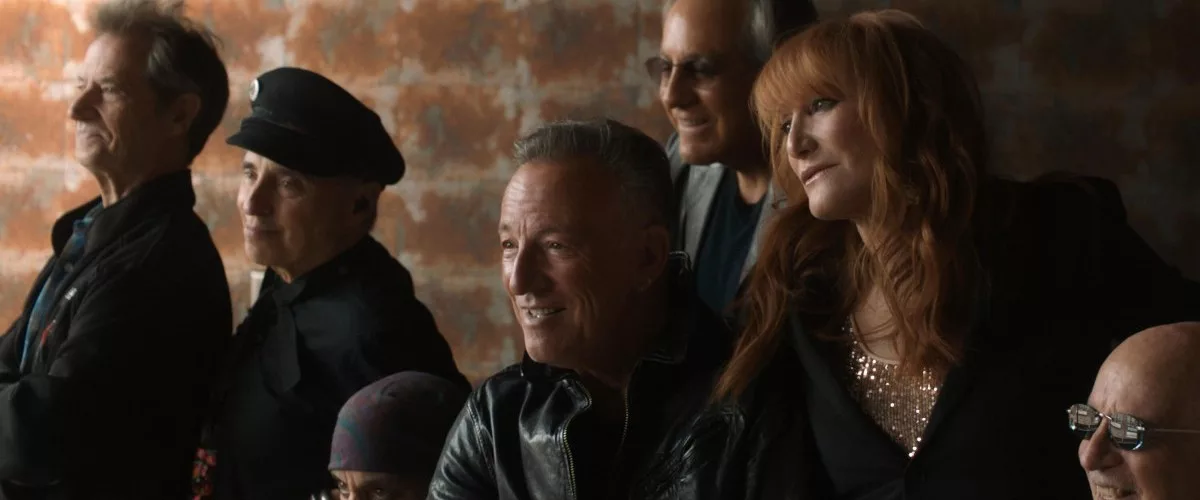When the world shut down in 2020, effectively suspending live music, missing out on legacy acts like Bruce Springsteen & The E Street Band felt an extra sting. In the autumn of their lives, there were fewer shows and less time to exercise the craft that had defined their existence. For these artists, the last time many of them had even been in a room was the recording of Letter to You (2019). So when they assembled in Red Bank's rehearsal studio to prepare for their return tour, it was with a clear narrative in mind.
Thom Zimny's reflective documentary "Road Diary: Bruce Springsteen and the E Street Band" is an intimate portrait of the band as they work to honor their history while looking forward to what may come. With his history around the Boss—Zimny is essentially the chronologer of the artist—he has an uncommon rapport with the band. That closeness, particularly the behind-the-scenes elements of how Springsteen and co. build a setlist, is invaluable in a film whose message is as direct as the concerts it's capturing.
The film is unofficially separated into several parts. The first twenty minutes or so are the band's rehearsals. Springsteen's narration explains his goals for these run-throughs: Shake out the cobwebs and find the story you want the setlist to tell. For the most part, during these early scenes, the band's primary fear is that they may be unable to deliver the kind of show the fans are used to seeing. The band is, after all, several years older, in a profession where the years have been increasingly felt since the last time they performed live. Tellingly, the first time they play through She's the One, it's noticeably slower than usual. There are also new band members, like singer and percussionist Anthony Almonte. There are also new songs from the album "Letter to You" and Springsteen's R&B cover album "Only the Strong Survive," two albums that, like this film and the tour it captures, are a reflection on the past.
Similar to his setlist, which appears to be the film's guiding structure, the first few minutes establish the many losses Springsteen and the band suffered over the years. He reminisces about his first band, The Castiles, and the deaths of E Street saxophonist Clarence Clemons and keyboardist Danny Federici. Through songs like Letter to You and the archival footage of past performances and interviews with Clemons and Federici, what emerges is the picture of an artist who doesn't see a perfect performance as defined by accuracy. Instead, it's a vehicle for remembrance, connecting these songs and this band to the memories shared with fans and each other.
Zimny jumps back and forth from the contemporary tour to footage of past gigs from prior decades, juxtaposing the elation of playing shows again with a fondness for the rough and tumble driving between dinky dives and sparse crowds. In the contemporary scenes, Steven Van Zandt often takes center stage, leading rehearsals as the tour's Music Director. His mischievous sense of humor also provides further levity. Zimny speaks to the entire band: Garry Tallent, Roy Bittan, Max Weinberg, Nils Lofgren, and Patti Scialfa — who can be quite scathing. Tallent is especially exhausted just thinking about how, in years past, Springsteen rigorously sound-checked (walking around every row of an arena to hear the music while the band played for hours on end). The openness of these interviews is just another sign of how comfortable the parties are around Zimny.
This film, like many other road documentaries, is, of course, carefully curated. Zimny is respectful of his subjects to a fault, never pursuing the Boss' lightening of the band's workload (Van Zandt even observes that the rehearsals were far too short, requiring him to lead the band for additional time). Zimny also includes interviews with fans who speak about what it's like to see the band back on the road. These moments are thoughtful in concept but aren't organically weaved in.
The film is strongest when we see Springsteen and company build these performances. Because Springsteen wanted the setlist to have a story, the list of songs rarely changed from night to night (a noticeable alteration for a band known for taking audience requests). A great example of this building is how his cover of the Commodores' Night Shift evolved during touring. I personally wasn't enamored with his reworking of the track for "Only the Strong Survive." The heart and soul of the song is its harmonies, and Springsteen subtracted those for his studio version. For the live shows, however, we see him work with his singers to bring those components back in, making Night Shift a highlight of the tour. These moments of evolution are so enthralling, you wish there were many more.
The steady setlist and how the songs speak to each other further clarify the emotional themes of the documentary. As we move through the film, arriving at Springsteen's solemn ode, Last Man Standing, the feeling of grief pervades every frame. Here, it all clicks into place: "Road Diary: Bruce Springsteen and the E Street Band" isn't looking to put a new spin on a familiar artist. It wants to rotate, spinning round and round from A-side to B-side to back again until the sense of mortality at the heart of this tour becomes as unshakeable as the music itself.




















